.jpg)
What It’s Like to Cross the Kalahari in a 4x4? Our Filmmaker’s Photojournal
A forgotten laptop on the hood of a 4x4. A box of SD cards flung somewhere into the Kalahari. The sun already dipping low. For Mael, our filmmaker on this journey, this moment captured the essence of extreme overland expeditions: unpredictable, sometimes stressful, but quietly profound.
“On the way back, I crossed my fingers, hoping to find my box of SD cards on the track…” he recalls. “And there, as if by magic, the guide we met earlier reappears out of the darkness. He’s driving in the opposite direction, stops next to us, and holds out the box: ‘Would this belong to you?’ I’m speechless. Luck? A star shining over me? It doesn’t matter—it’s simply exceptional.”
For Nomadic Road’s filmmakers, expeditions are just as intense as they are wild. And this particular one to Kalahari is no tourist jaunt.
For those curious about the Kalahari Desert, it’s a vast semi-arid region that spans Botswana, Namibia, and South Africa.
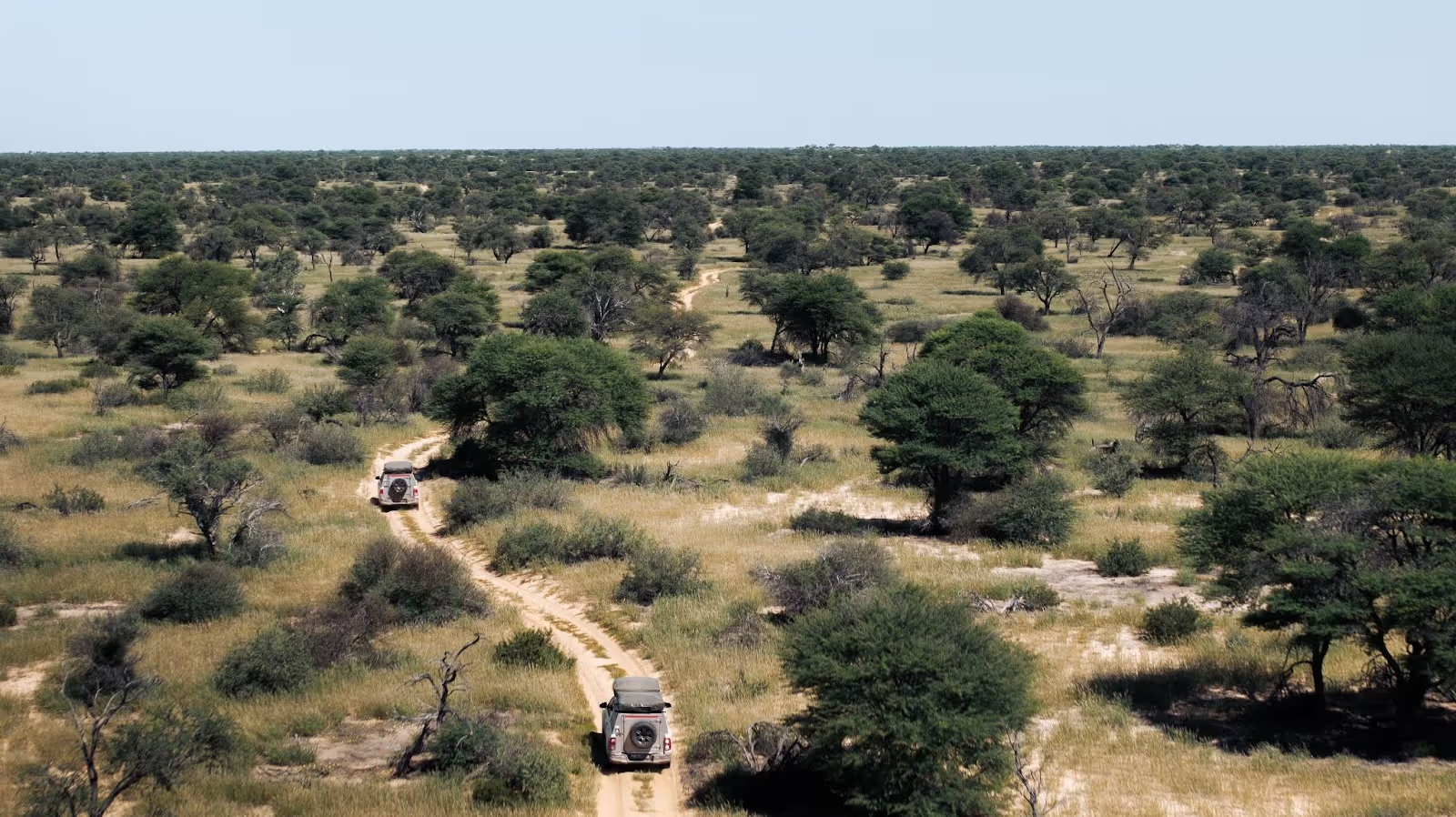
Only a few have the guts to take on Africa overland. This isn’t a cushy trip. We navigate dirt tracks, dry riverbeds, and dunes that could swallow you whole if you let your guard down.
What follows is a photo essay shot by Mael: his lens, his words, and his experience. The text has been lightly edited, but the story is entirely his. A personal chronicle, coupled with the best desert photos.
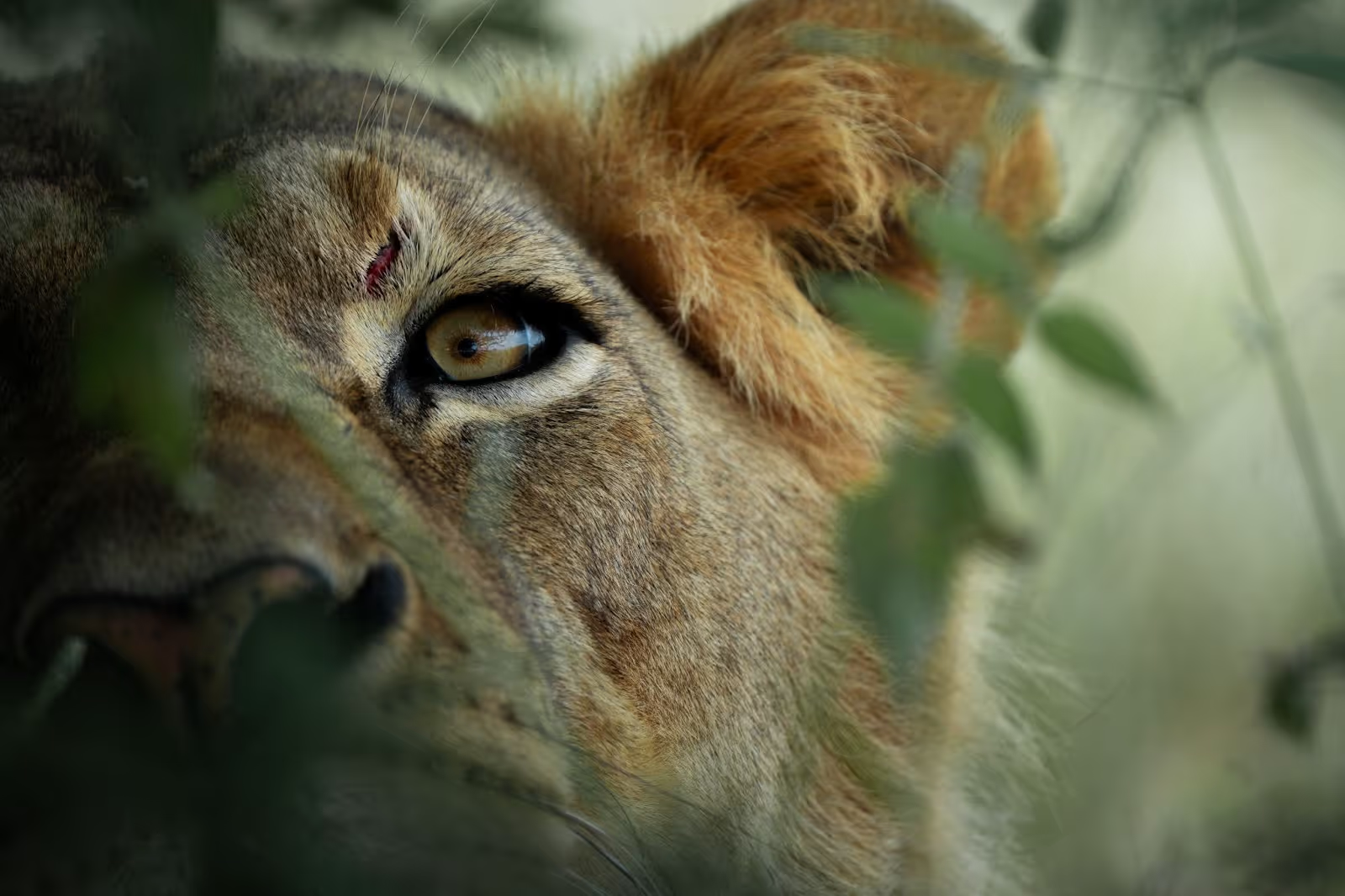
On day one, in the late afternoon, we set off on our first day in the wilderness. A few kudus (a grand antelope) appear by the track. Then, as if sprung from a dream, a pair of lions stands before us, majestic and serene. The male and female mate several times. Silence reigns, suspended.
The Kalahari Desert’s location shapes a habitat where hardy wildlife battles the relentless arid expanse.
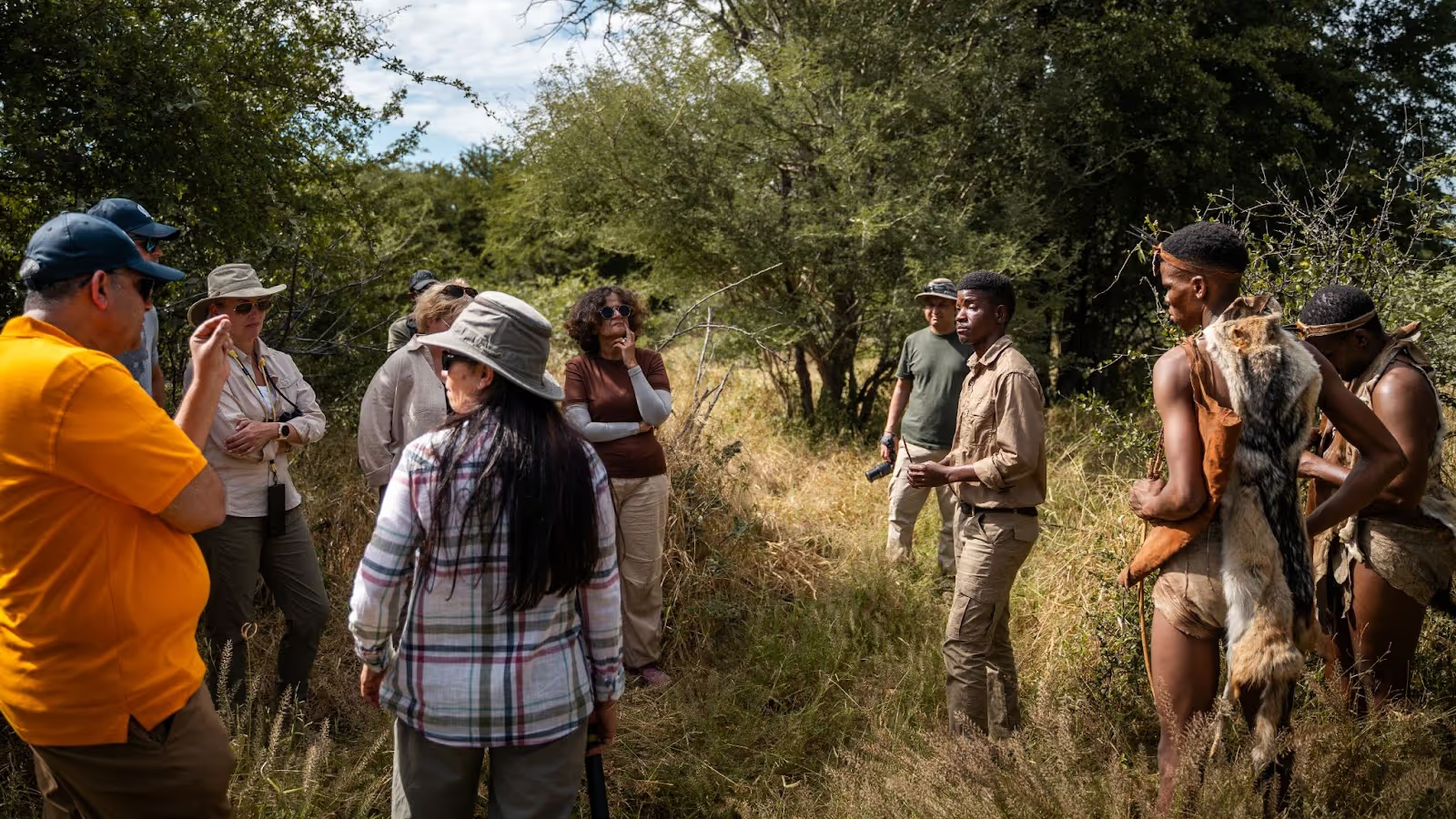
It’s only day two, and from our terrace, we spot an impala and her calf hiding just steps away in the bushes. Later, on a guided walk, our guides introduce us to the Bushmen’s ancestral survival techniques.
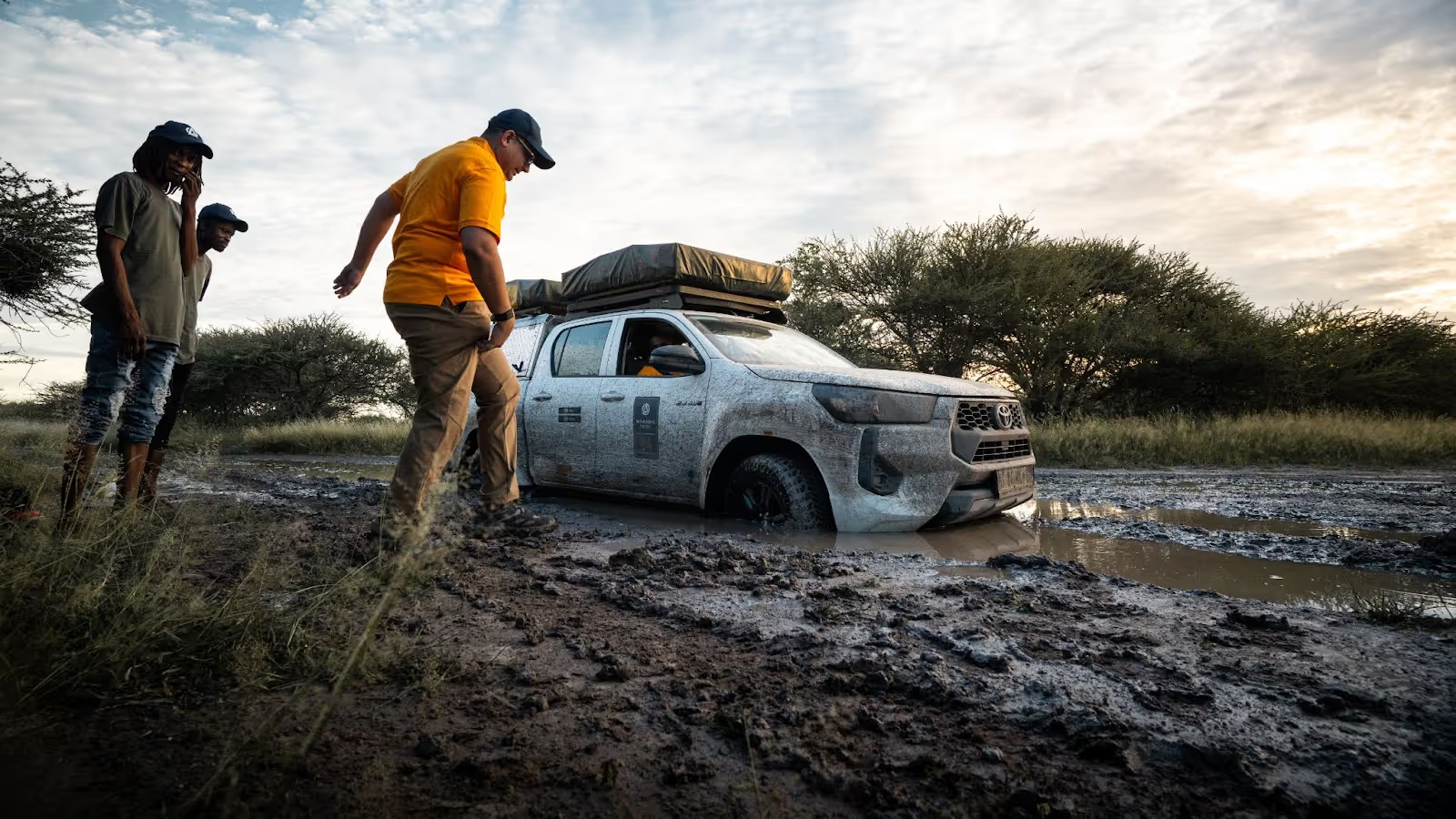
After several hours on a bumpy track, with water-filled ruts sometimes rising to the car doors, we finally reach Deception Valley. A herd of springboks and some magnificent oryx graze in a vast plain of tall grasses. In the background, large acacia trees carve silhouettes against the sky… a dream for desert landscape photography enthusiasts.
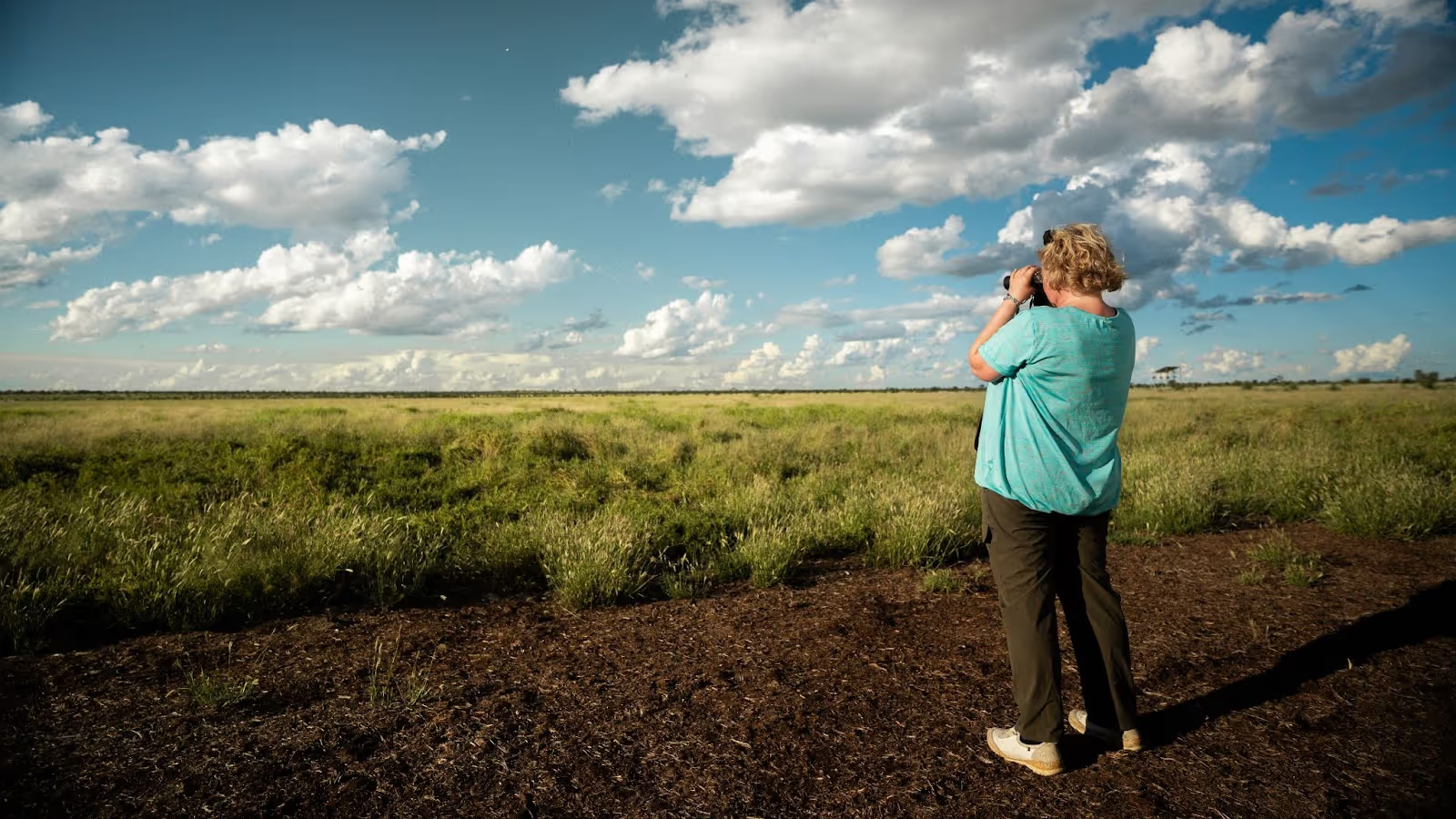
On day three, the track is less waterlogged than the day before, but the vegetation is still dense. The exceptional rainfall of the past few weeks has transformed the landscape: everything is a vibrant, almost surreal green for a region usually so arid.
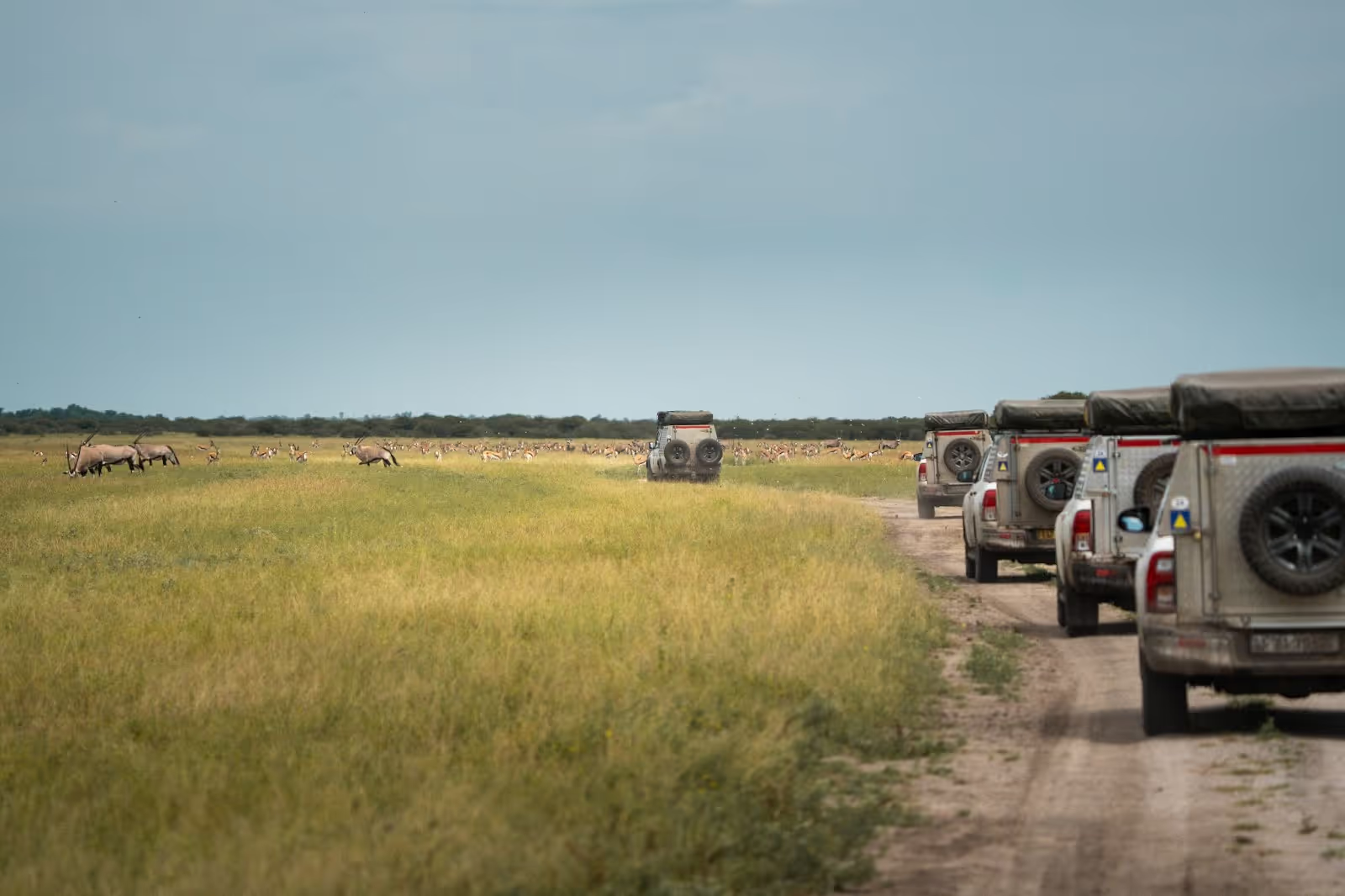
Today, the first springboks and oryxes appear… peaceful silhouettes amidst the lush vegetation. A little further on, a young lion rests just a few meters from the track. Later, a jackal crosses among the oryxes, ostriches spring up out of nowhere, and a slender figure catches our eye: a large brown gazelle.
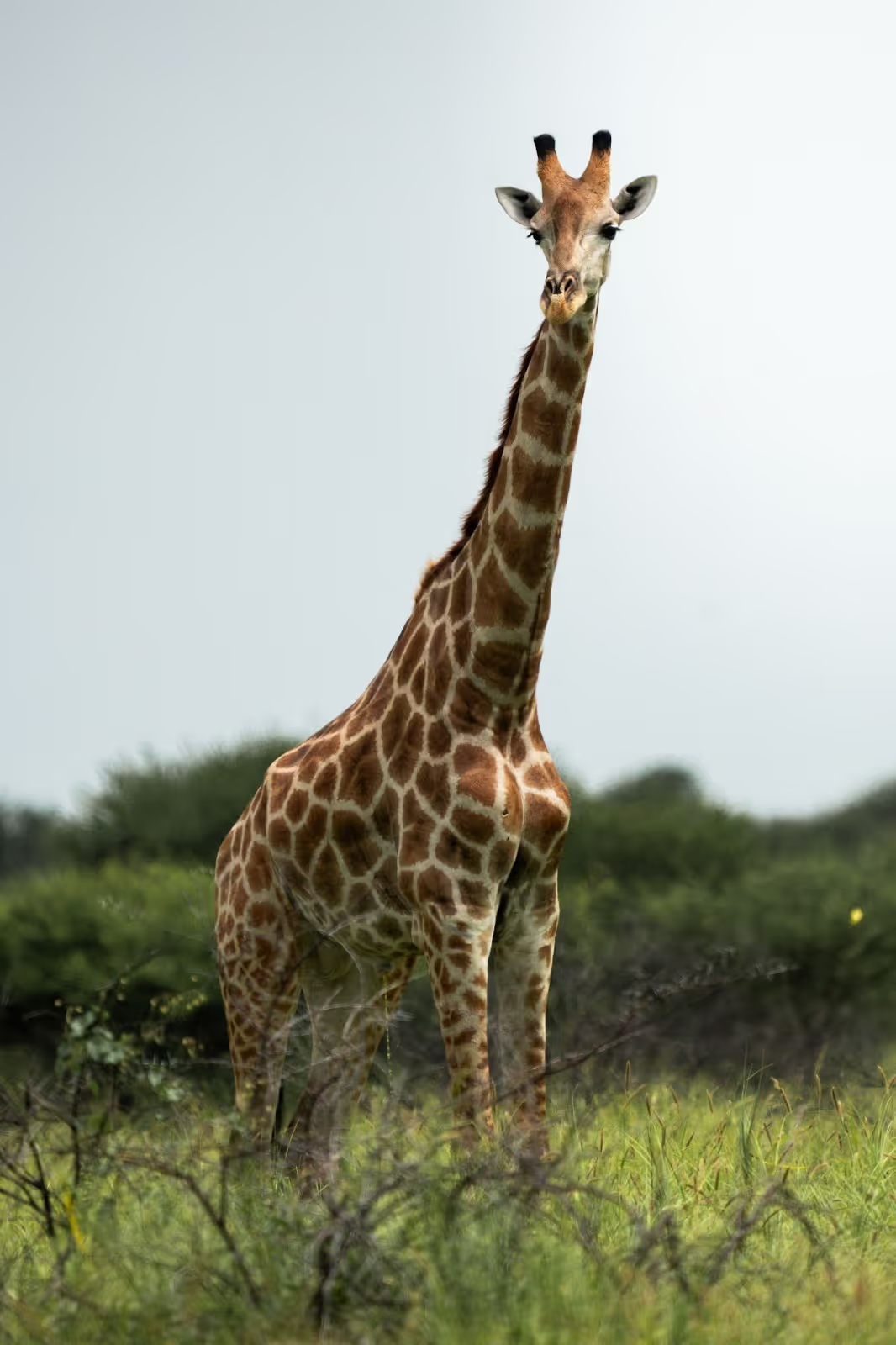
Then come the giraffes, the wildebeests, and even the world’s largest flying bird—the Kori bustard. The Kalahari is bursting with life.
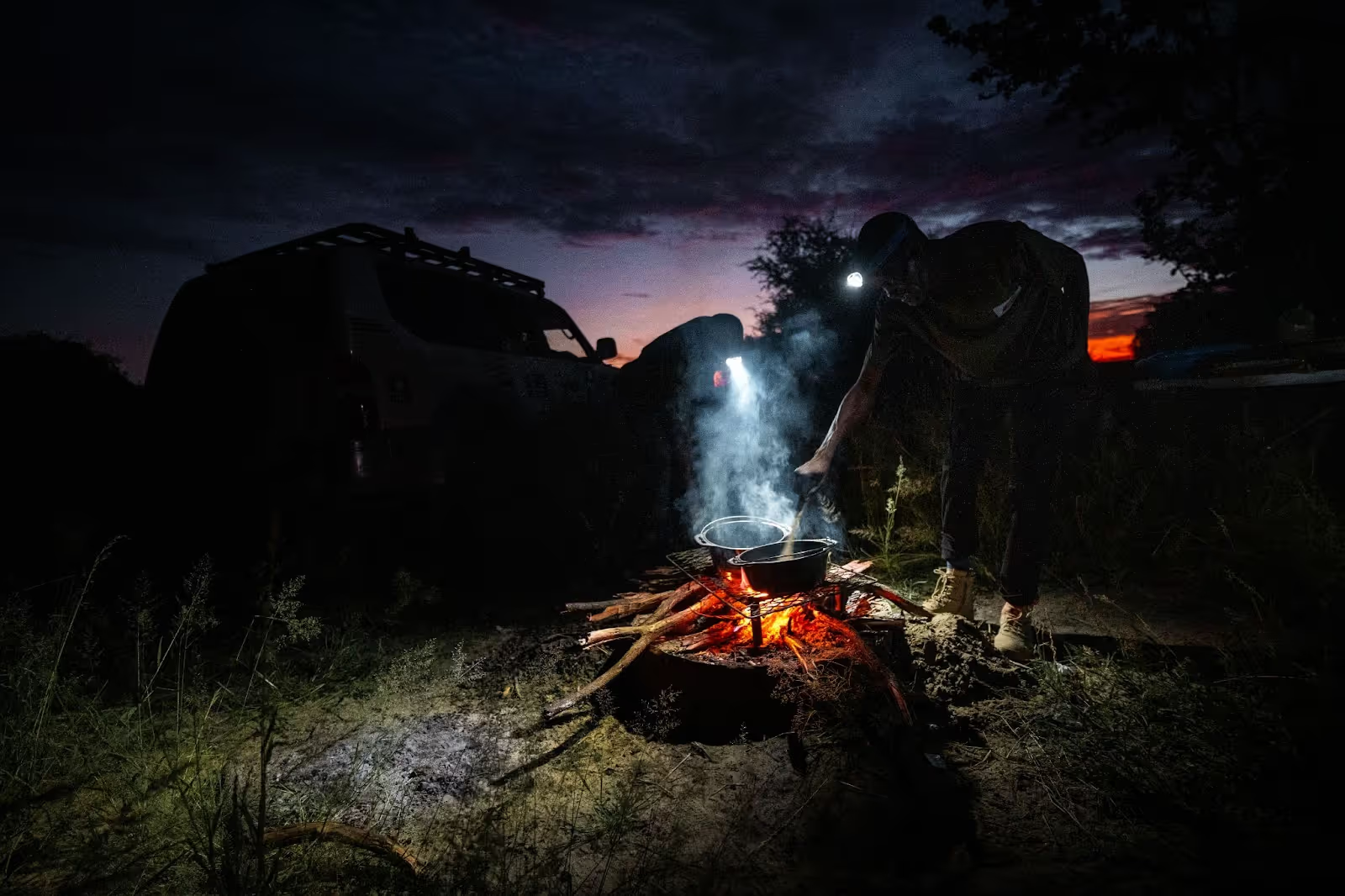
It’s 9:44 p.m. After a good meal of rice, chicken, and vegetables at the campsite and a quick shower using a water bottle, it’s time for bed. Tomorrow brings a 6 a.m. wake-up call to observe wildlife near a watering hole. Another day of wonder awaits.
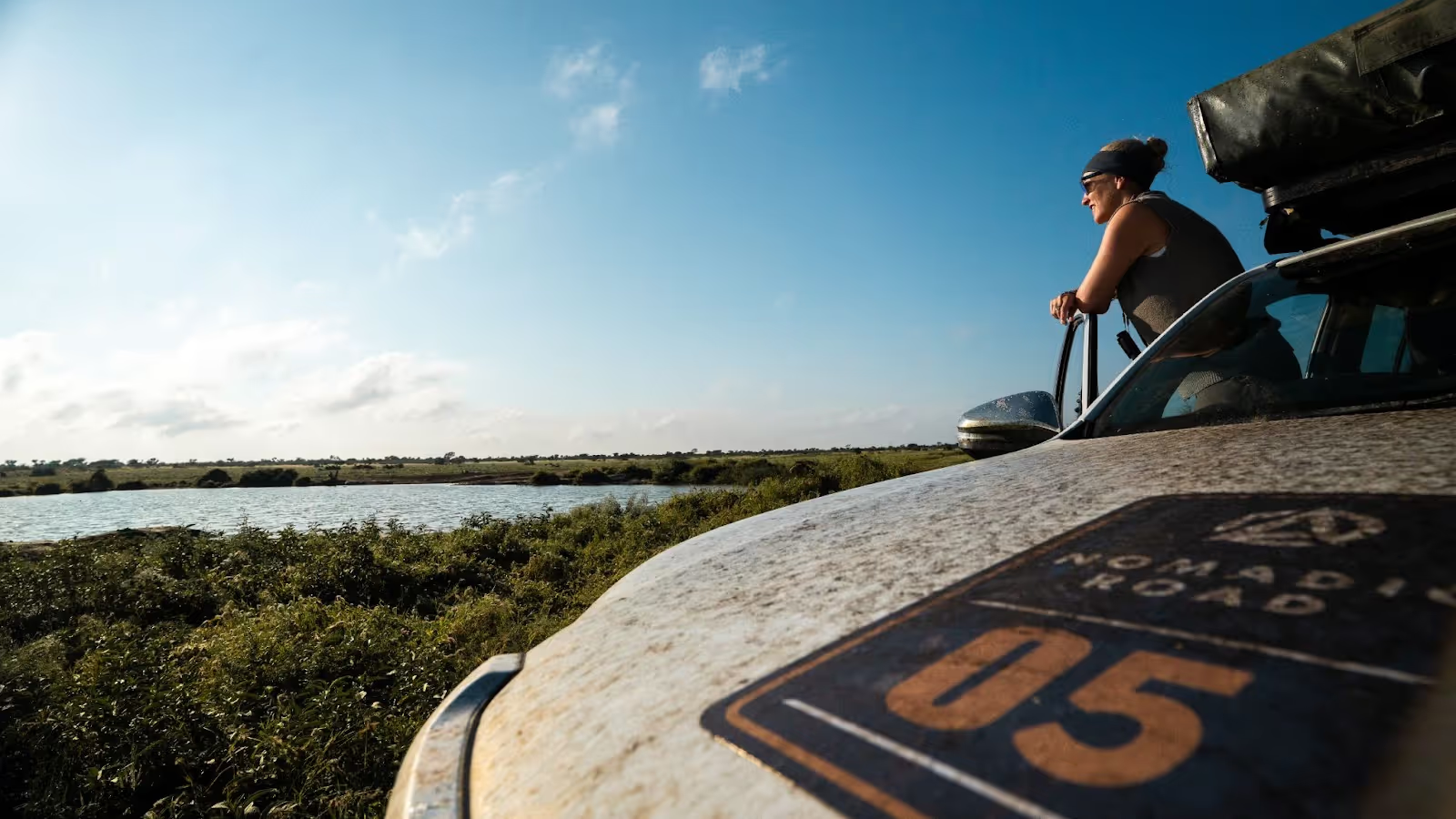
Day four, and we hit the road toward our next campsite. The track is bumpy—not especially difficult, but seemingly endless—bordered by dense, thorny bushes that brush against the car’s bodywork. Occasionally, rare openings onto plains break the monotony, where tall grass rises to the doors.
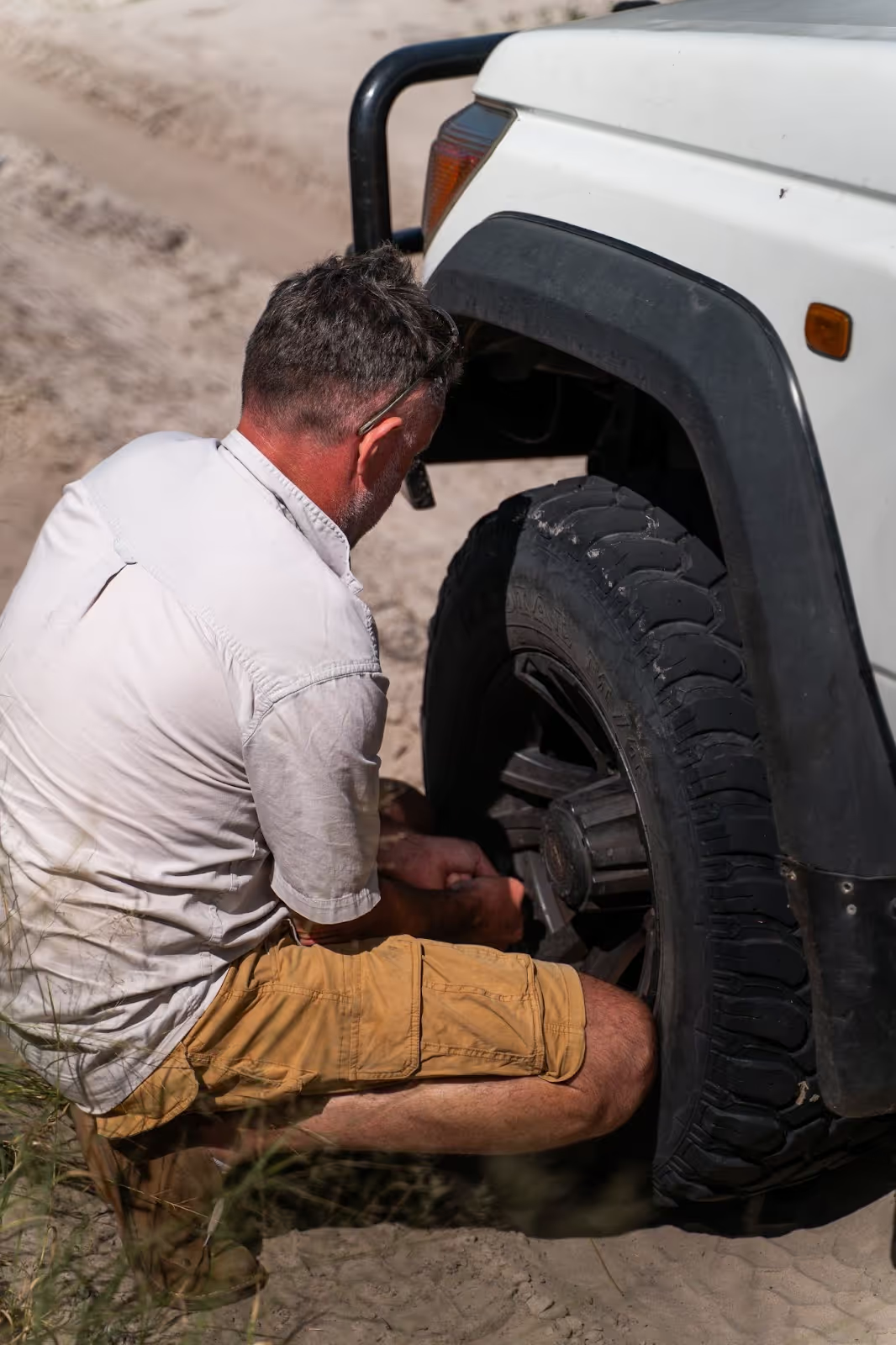
Day five promises to be intense: nearly 155 kilometres of track ahead. About halfway through, the Indian-Canadian couple gets a flat tire, forcing a stop and a tire change under the blazing sun. Luckily, the rest of the journey goes smoothly.
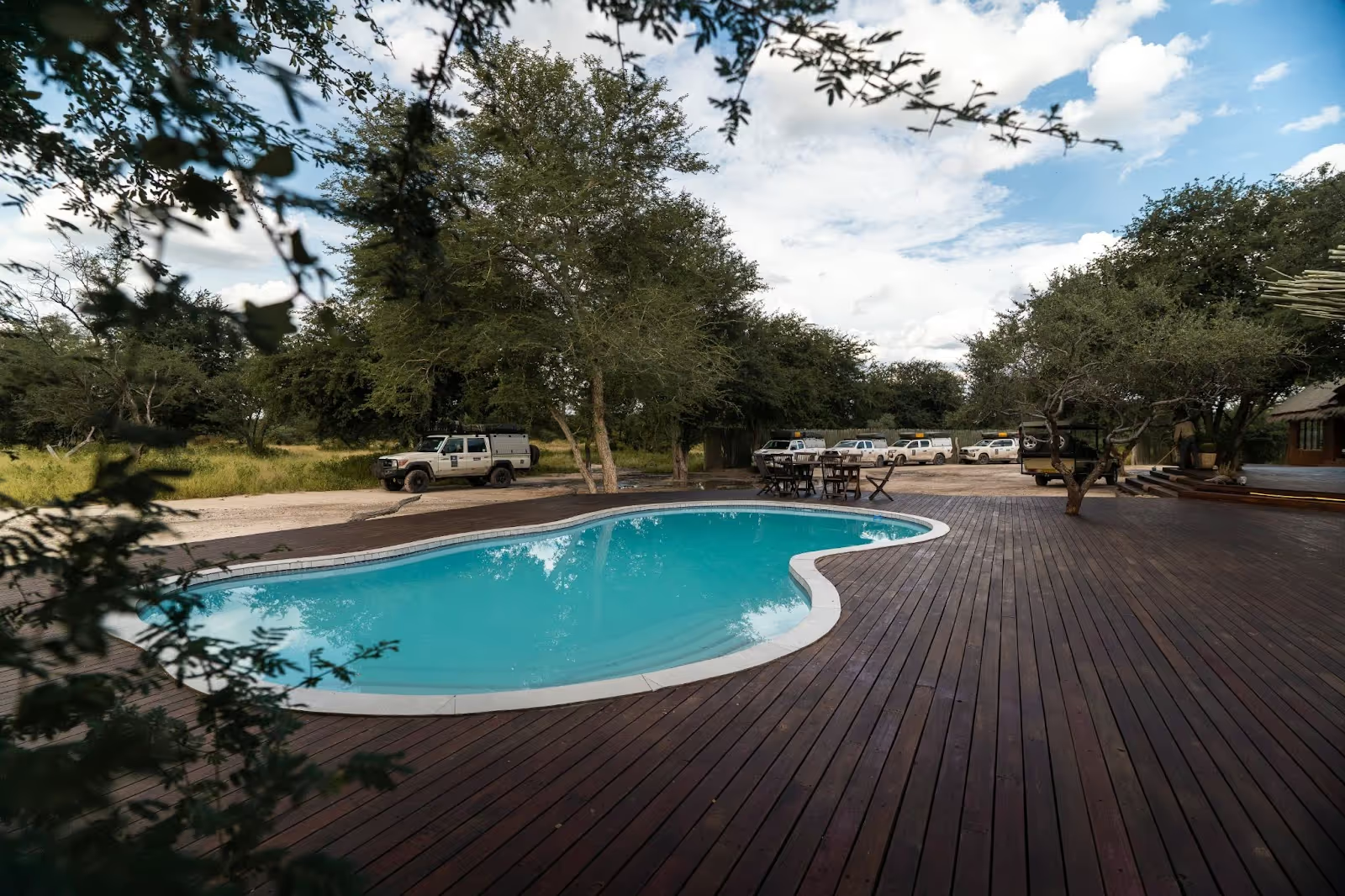
When we arrive, the campsite is spectacular: a grandiose setting, deep in the heart of the Kalahari. Just like the day before, lightning dances on the horizon, striking the distant Botswana ground… but once again, we enjoy a dry evening.
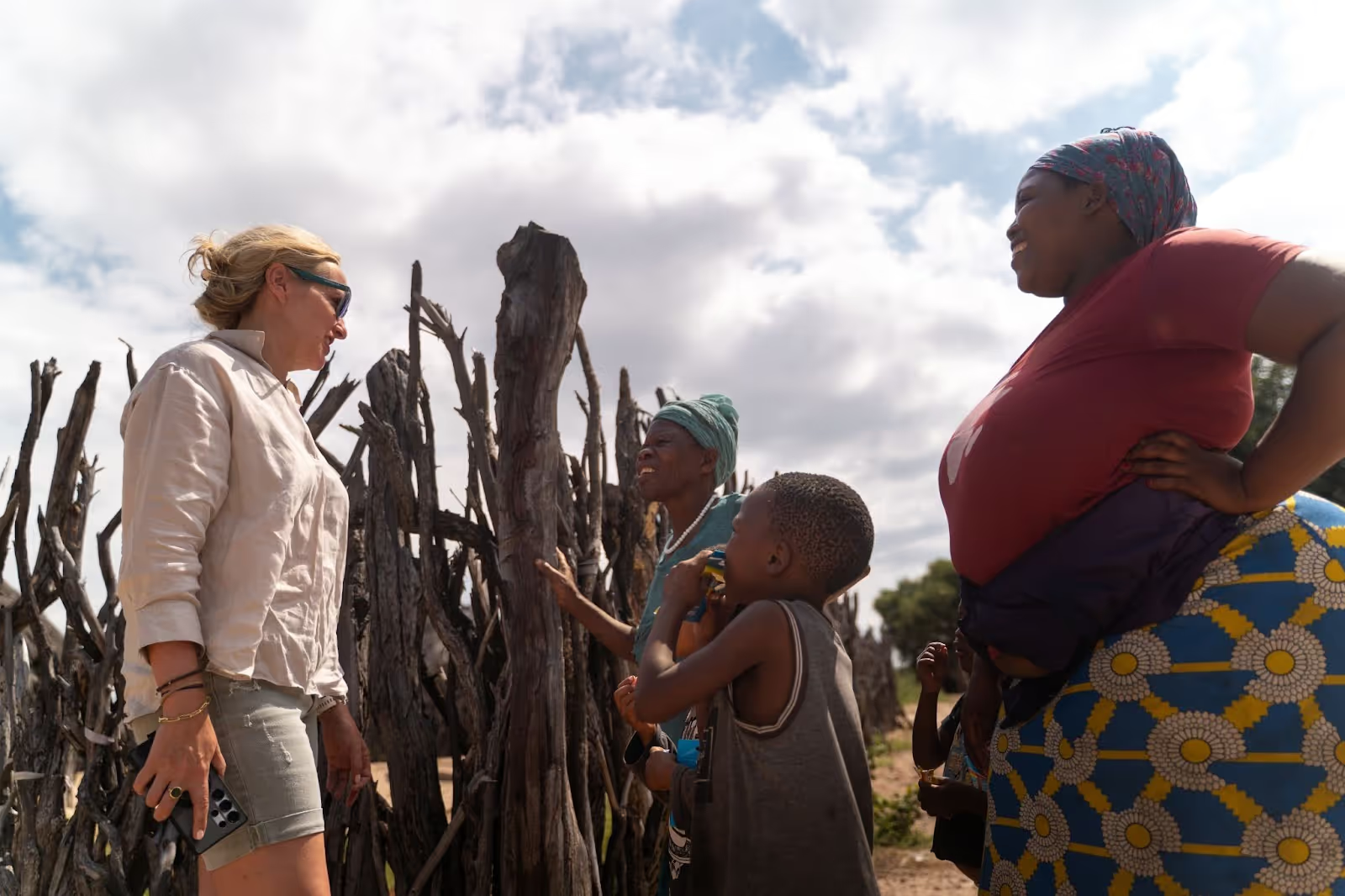
On day six, we pass through two Bushmen villages. We stop, play soccer with the children, and offer them clothes and sweets—a simple yet powerful moment of sharing. The rest of the day unfolds along a sandy track choked with bushes. A giraffe is spotted by part of the group, a jackal, a few birds… and then, emptiness. The Kalahari can be stingy.
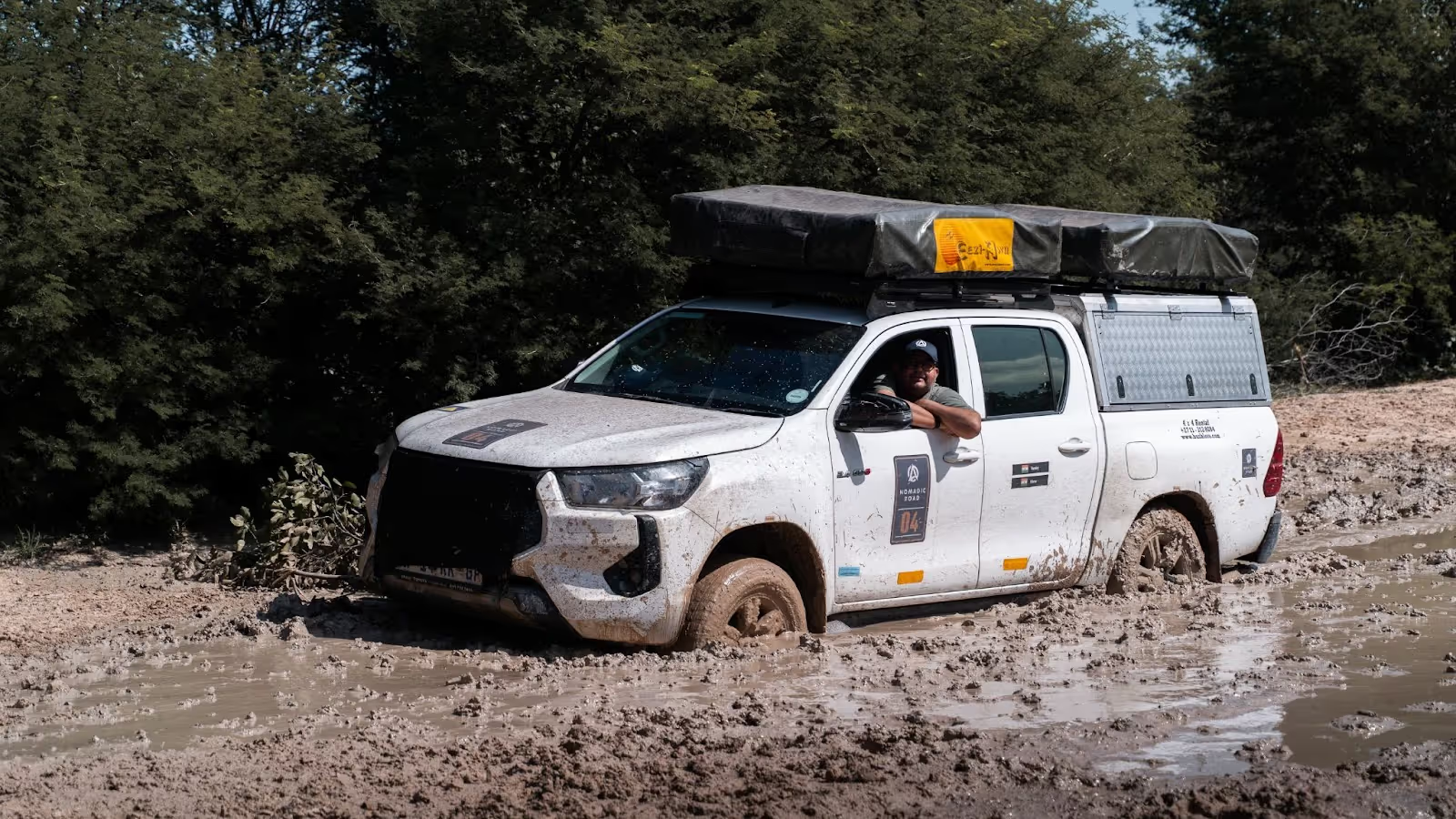
Day seven. I wake up at 5:30 a.m., with lions roaring near the waterhole. It’s a long day ahead: nearly 340 kilometres. Strangely, Mr. Uchil and Nirav get stuck on what might be the easiest stretch of the trip: a short, muddy patch everyone else avoids. Mr. Uchil veers right into it. Rob, the expedition leader, turns back and pulls "Nomad 4" out of the quagmire—again.
We spend the night in a lodge—nothing special in charm, though well-equipped. At first, there’s no water, then only cold. No matter: the evening is unforgettable, filled with laughter and animated conversation around a big communal table.
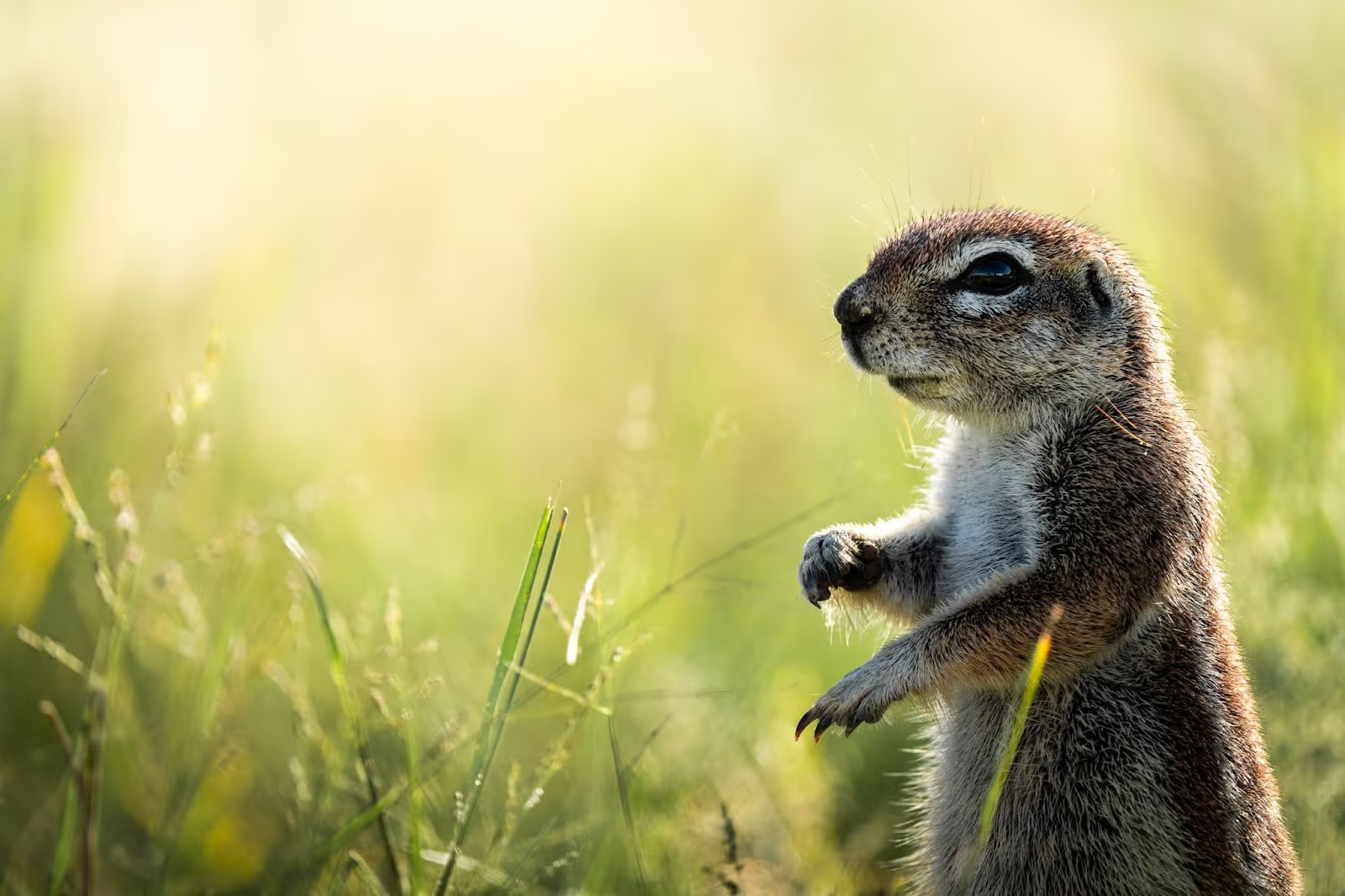
Day eight: We have about 250 kilometres to cover, and by afternoon, everyone’s exhausted. The road has taken its toll. Around 4 p.m., we head out to explore. We spot a large tortoise, some playful squirrels, meerkats, ostriches, and a few stately Kori bustards.
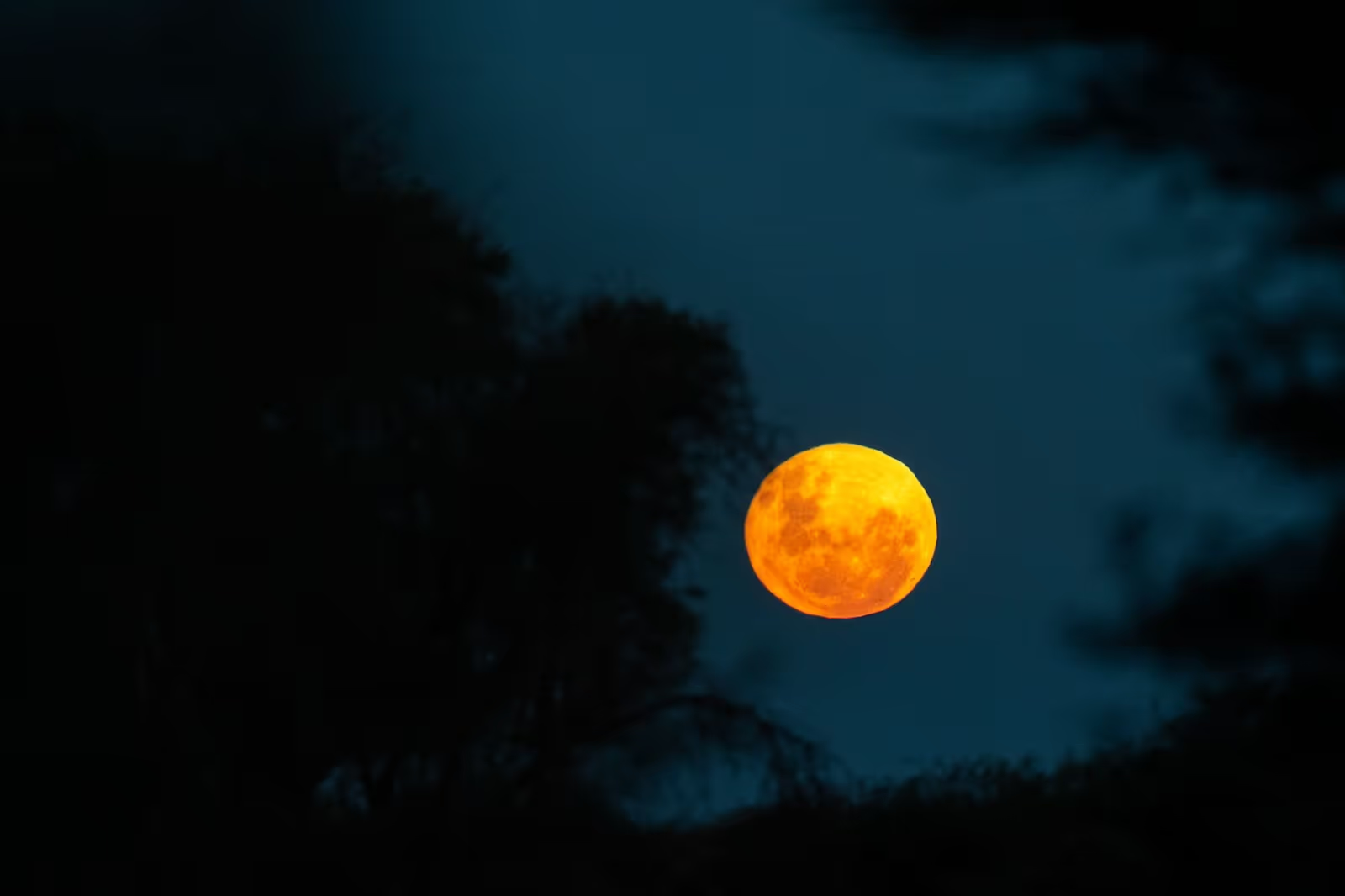
On the way back, the full moon rises: red, massive, and surreal. The starry sky and camp atmosphere feel magical. Rob cooks up a feast: rice, fire-grilled meat, and a delicious potato-and-carrot sauce. A real treat.
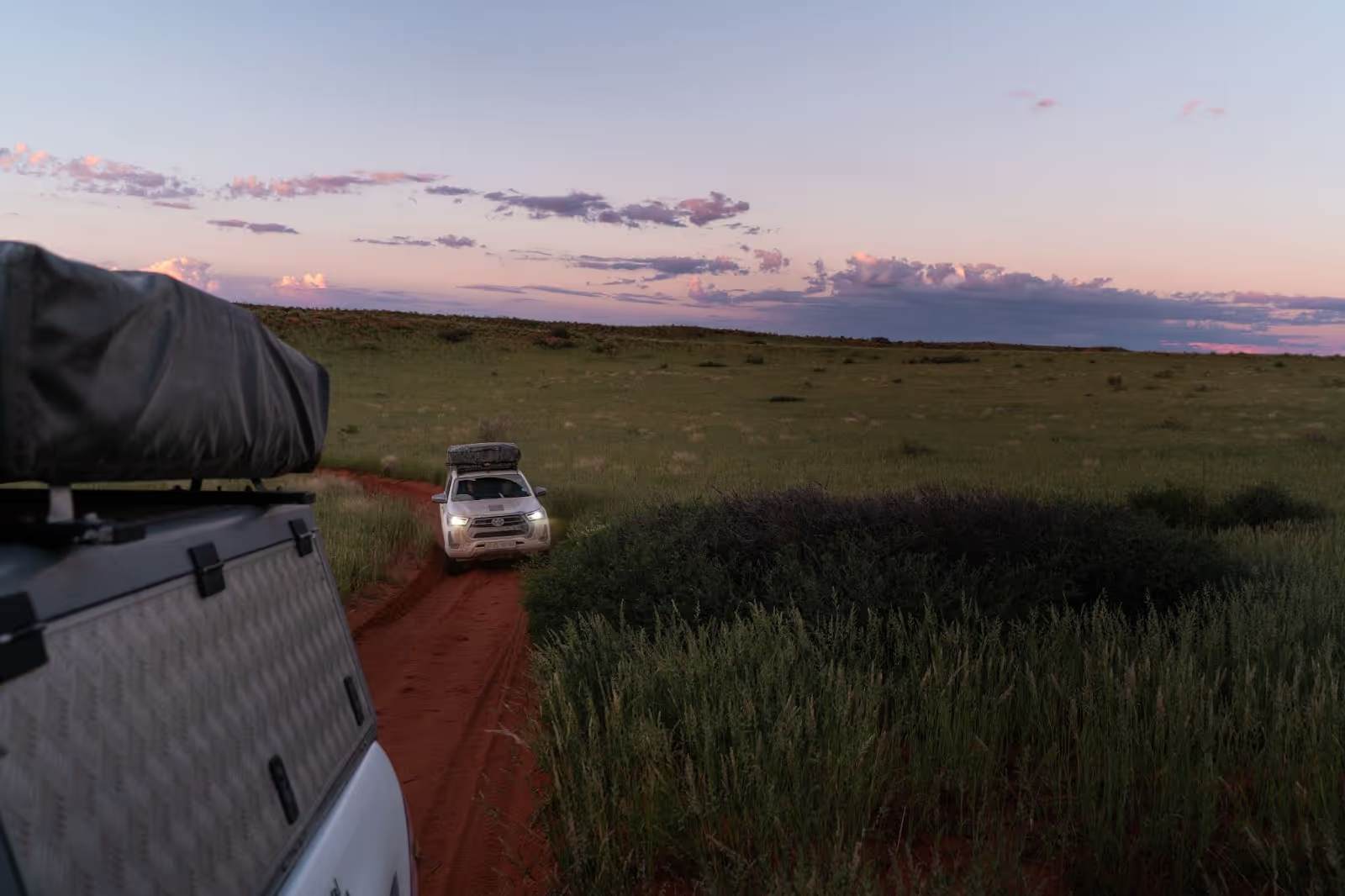
Day nine has in store a long drive across the dunes—a heady mix of speed, drifting, and pure adrenaline. Unlike the muddy, technical tracks before, this feels like a dance with the desert. At full speed, we skim over dune crests, slide down slopes, and bounce across golden ripples, intoxicated by the sheer sense of freedom.
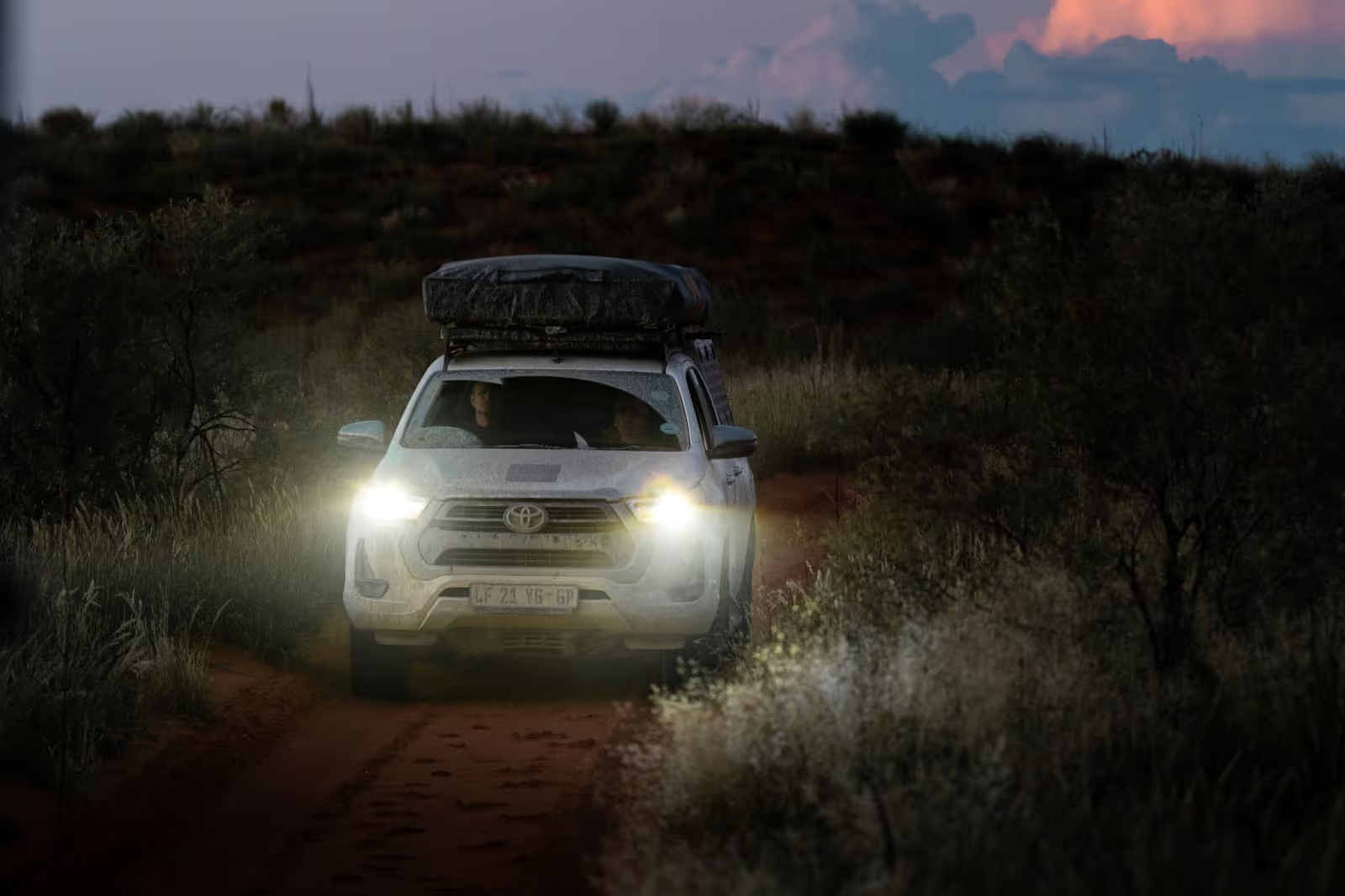
But the flip side of the adventure soon catches up. At the base of a towering dune, Nirav’s car gets stuck. The wheels spin helplessly.
The heat is crushing, the sun beating down mercilessly. The air is thick, almost suffocating. Nirav’s engine starts to dangerously overheat, the water level dropping alarmingly low. Every minute stretches the ordeal longer.
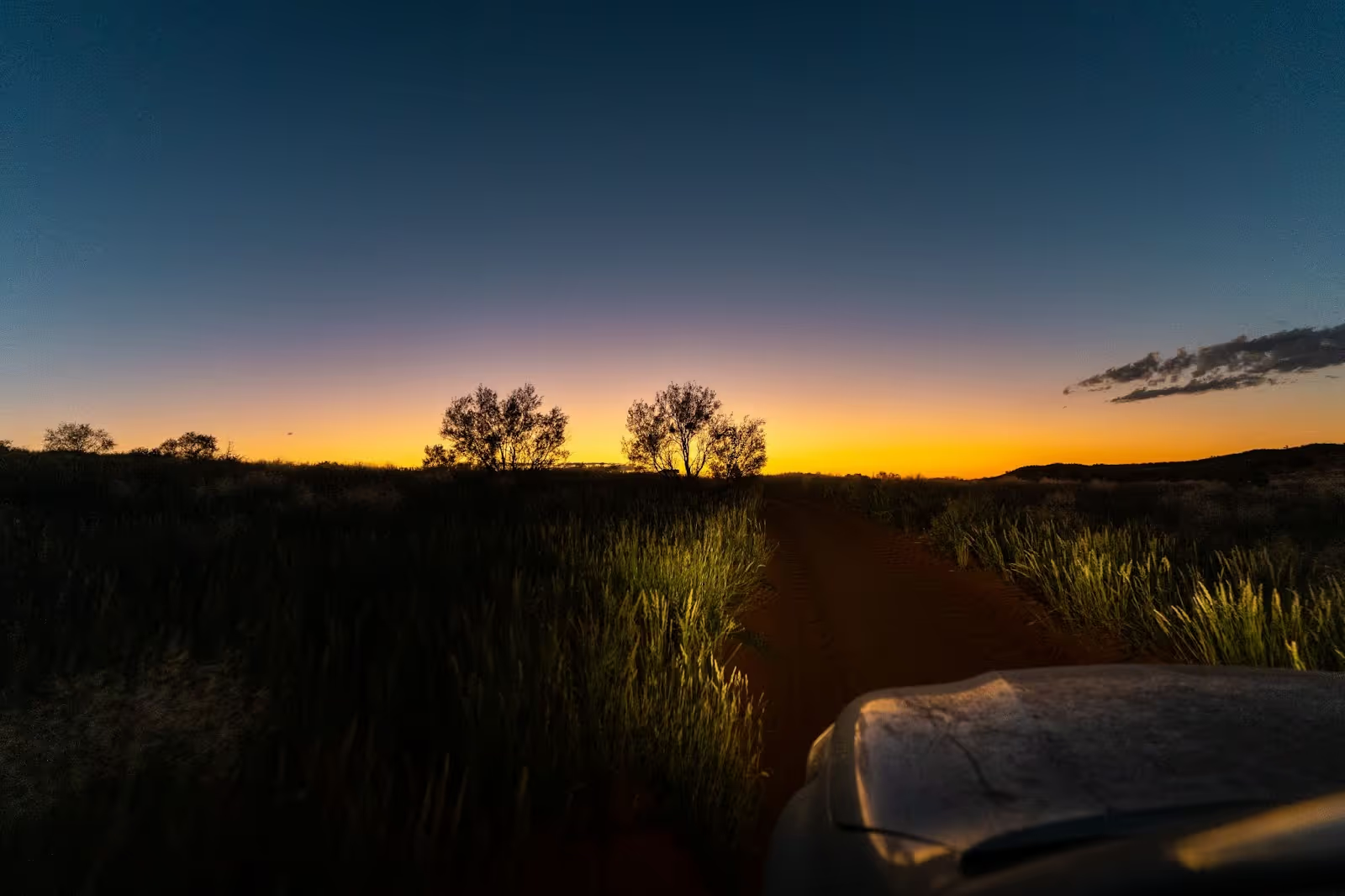
In the end, we hook their vehicle to Rob’s 4x4. Engines roar, sand flies, and with one massive effort, we finally pull them free. Exhausted, drenched in sweat but proud, we dive back into the red-and-gold ocean of the desert, spirits high and stronger than ever. The sky explodes into vibrant colours, from fiery orange to soft pastel violet. It doesn’t feel real.
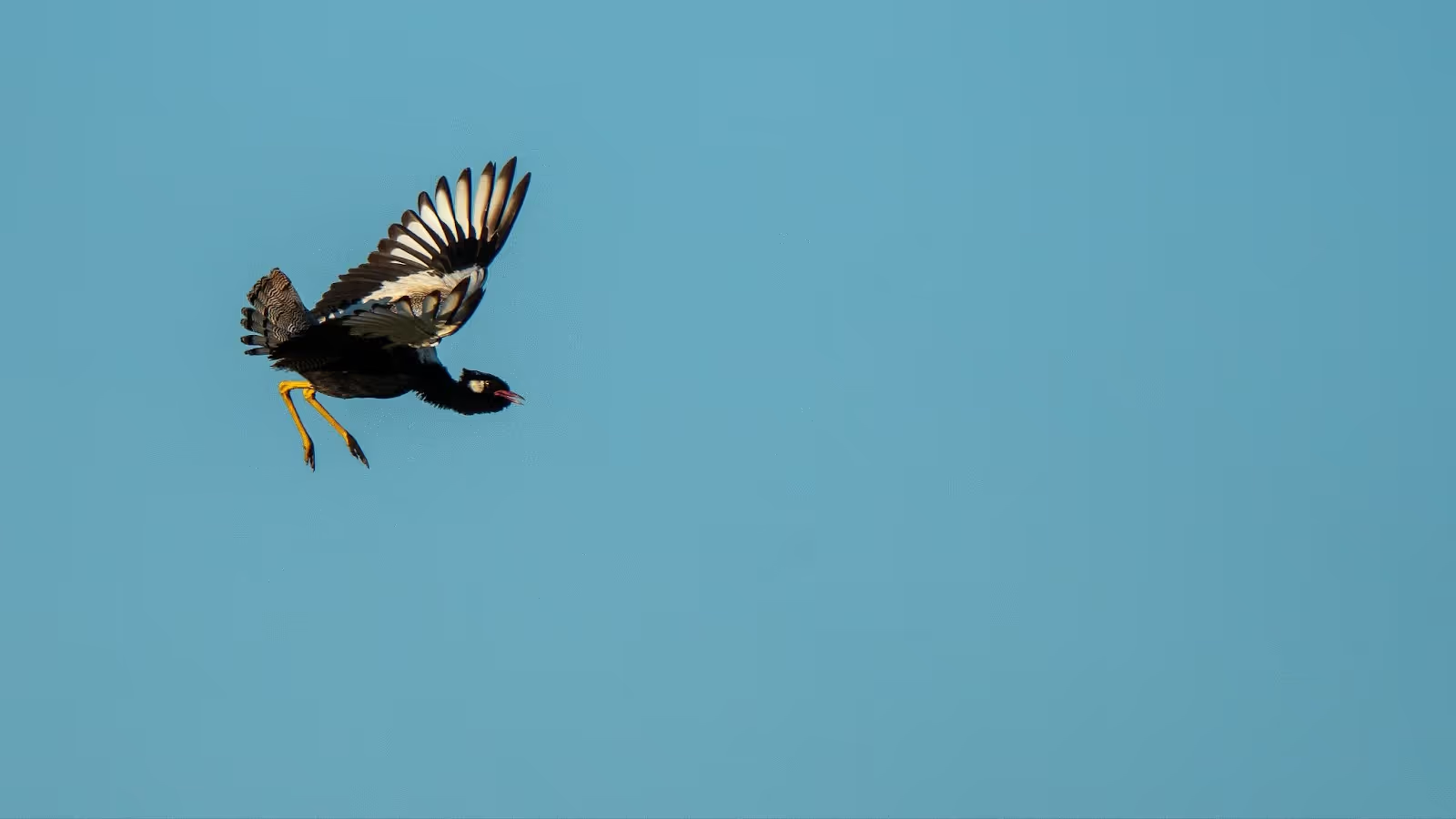
Day 10 begins with a short nature hike: we spot tracks, study plants, and feel the rhythm of the land. At sunset, another safari—ostriches, oryx, and brown gazelles. The day ends with, in my opinion, the trip’s best meal: a rich, soul-warming beef bourguignon.

On the road to Kalahari Game Lodge on day 11, we witness something extraordinary—a cheetah beside its fresh kill. Later, Rob helps a massive tortoise cross the road. Then, over the radio: “King cobra on the road!” The wild keeps surprising us.
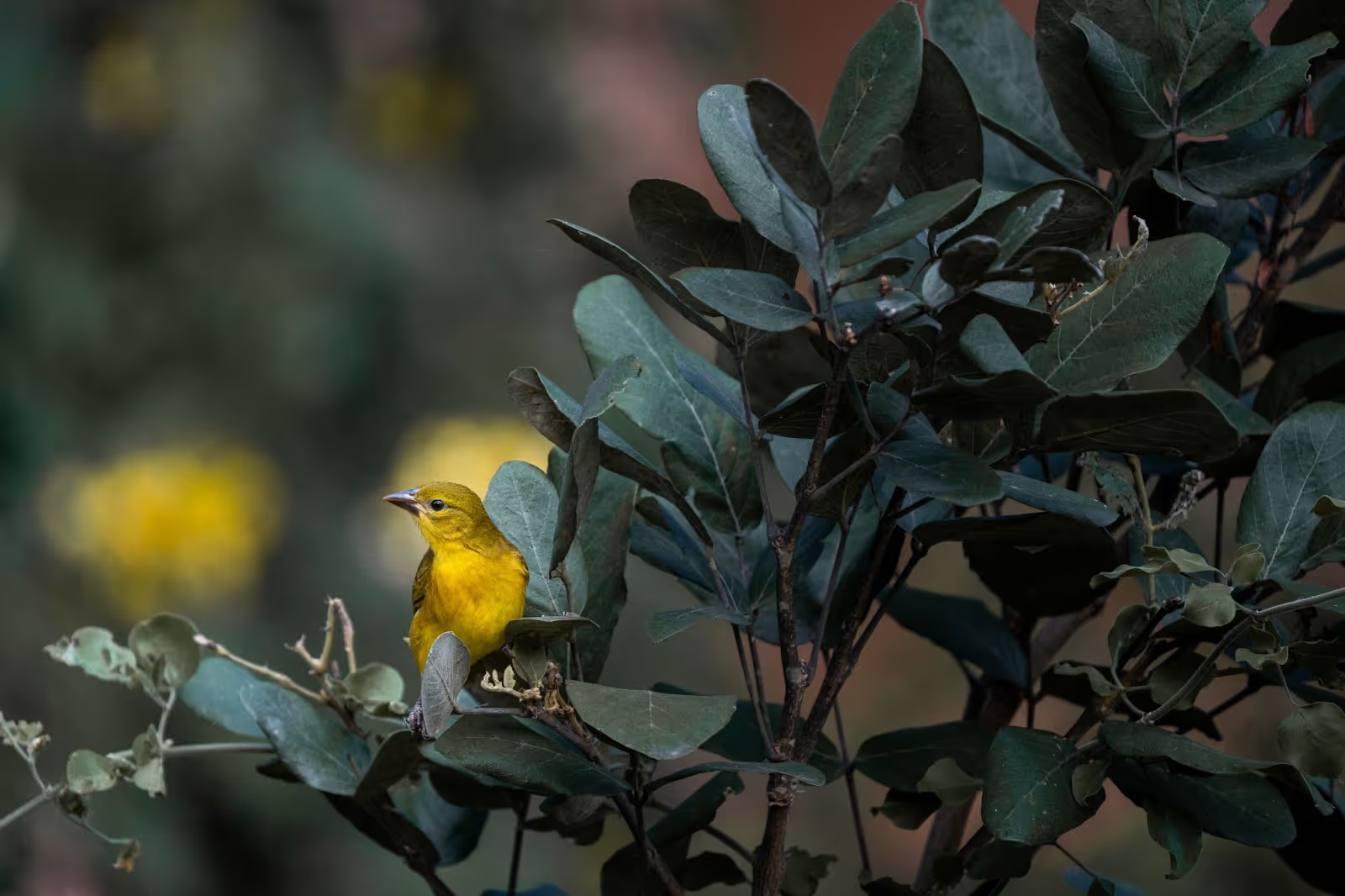
Day 12. I rise early to catch the soft light of dawn. Songbirds flutter around the lodge—a final, quiet moment to savour and capture some of the best desert photos.
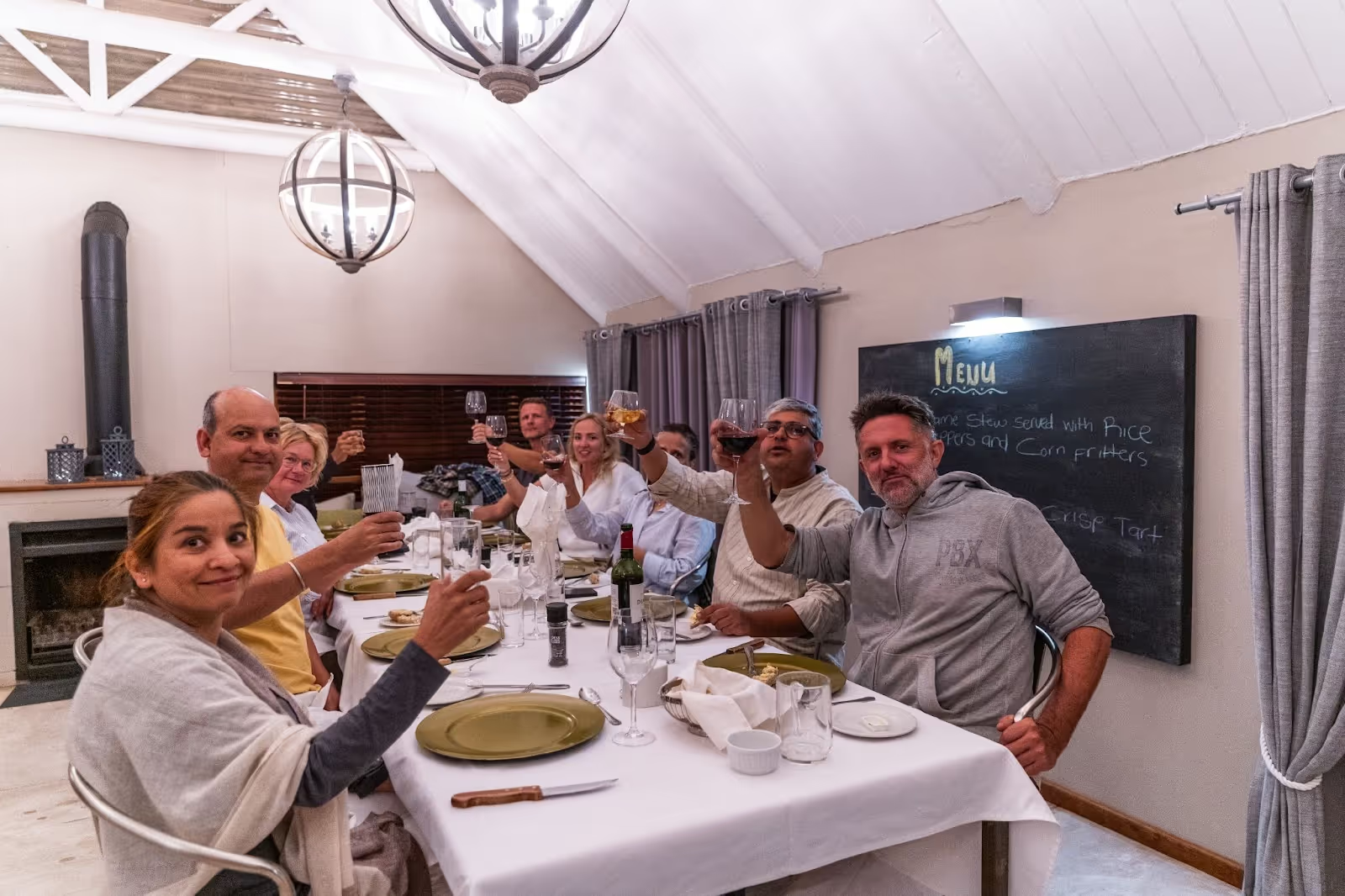
At 9:30 a.m., we begin our last drive: 600 kilometres to Windhoek. The final chapter in a journey that has given us dust, wonder, and everything in between.
When you think about the Kalahari Desert, you might imagine endless sand and silence. But out there lies a surprising world teeming with life and colour, as brought to life in Mael’s stunning visuals and words.
Sometimes, you must see it to believe it.
RELATED STORIES
%20(1).jpg)
A Rain-Soaked Desert? It’s All Possible on the Kalahari Expedition

We Went Looking for Adventure, but Mongolia Gave Us Much More


